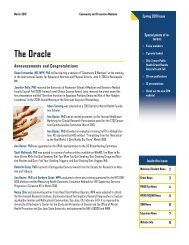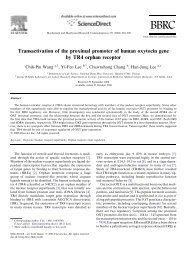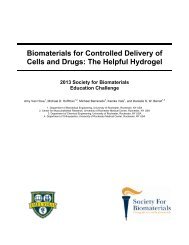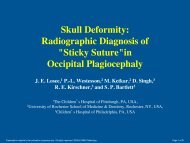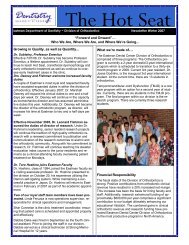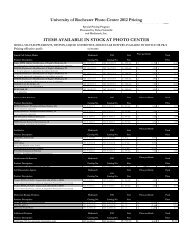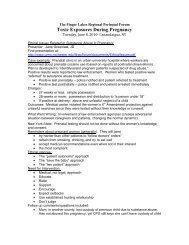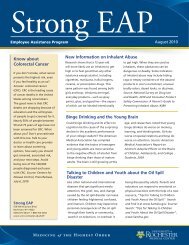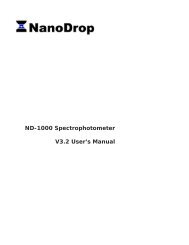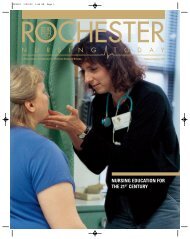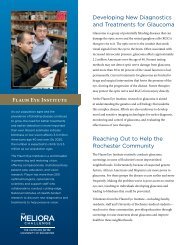Fall/Winter 2006 - University of Rochester Medical Center
Fall/Winter 2006 - University of Rochester Medical Center
Fall/Winter 2006 - University of Rochester Medical Center
You also want an ePaper? Increase the reach of your titles
YUMPU automatically turns print PDFs into web optimized ePapers that Google loves.
appropriate levels in young mice that are<br />
not expressed at those levels in old mice.<br />
One <strong>of</strong> the genes that is down-regulated,<br />
O’Keefe’s team discovered, involves the<br />
same Smurf that is a culprit in the development<br />
<strong>of</strong> arthritis. The lab also has<br />
shown that COX-2, one <strong>of</strong> the cyclooxygenase<br />
enzymes, may play an important<br />
role in maintaining appropriate Smurf<br />
levels and appears to be critical for fracture<br />
healing.<br />
“Smurf helps cause the transformation<br />
<strong>of</strong> cartilage that forms in fracture<br />
sites into bone,” Rosier said. “In the<br />
joint, that’s a terrible thing, but in fractures,<br />
it is part <strong>of</strong> a normal and necessary<br />
process.”<br />
The O’Keefe lab also identified an<br />
intercellular signaling pathway that<br />
controls the Smurf. The project will<br />
investigate the cellular mechanisms in<br />
maintaining the appropriate levels <strong>of</strong><br />
Smurf expression and the role <strong>of</strong> COX-2.<br />
A parallel project directed by Puzas<br />
and Susan Bukata, M.D., an orthopaedic<br />
surgeon, involves a clinical trial <strong>of</strong> teraparatide,<br />
a parathyroid hormone with<br />
the brand name Forteo. The hormone<br />
stimulates osteoblasts to form bone.<br />
When used in treating severe cases <strong>of</strong><br />
osteoporosis, the hormone can increase<br />
bone mass by 15 percent in a year.<br />
“One <strong>of</strong> our notions is that the<br />
hormone could substitute for the loss <strong>of</strong><br />
COX-2 that occurs with aging and restore<br />
the signaling that would enable the<br />
appropriate levels <strong>of</strong> the gene to be<br />
expressed, so cartilage turns into bone on<br />
schedule,” Rosier said.<br />
Rosier’s team also is the first to<br />
make a dramatic discovery about the<br />
hormone’s capabilities when given to<br />
patients with pelvic-insufficiency fractures.<br />
These stress fractures <strong>of</strong>ten fail to<br />
heal because they occur in elderly people<br />
with other health problems. After discussions<br />
with patients with the stress<br />
fractures, several received the parathyroid<br />
hormone.<br />
“Some had been in pain and in a<br />
wheelchair for a year,” Rosier said.<br />
“ Within a few months <strong>of</strong> taking the<br />
hormone, they walked into the clinic.<br />
X-rays showed the fractures had healed.<br />
We have now treated about 20 people,<br />
with almost all having healed. We have,<br />
in fact, had some patients with spine<br />
fractures in the neck who have<br />
completely healed.”<br />
Puzas and his group will quantify<br />
and map the healing <strong>of</strong> fractures in<br />
patients in a clinical trial <strong>of</strong> the<br />
hormone.<br />
The third major part <strong>of</strong> the CORT<br />
project addresses the revitalization <strong>of</strong><br />
allografts, the dead bone from human<br />
cadavers used to replace bone lost in<br />
severe trauma or cancer. Edward<br />
Schwarz, Ph.D., associate pr<strong>of</strong>essor <strong>of</strong><br />
orthopaedics, is the principal investigator.<br />
“The transplanted bone works well<br />
mechanically. It will fuse and provide<br />
structural support, but it never becomes<br />
a fully living bone,” Rosier said. “Fatigue<br />
fractures occur, and there’s no ability to<br />
repair. Living bone constantly repairs<br />
itself. There is a high failure rate in the<br />
long term for these allografts. It would be<br />
great if we could find a way to convert<br />
the graft to a living bone.”<br />
Schwarz has conducted in-depth<br />
studies <strong>of</strong> allografts in mice, tracking the<br />
cells that produce healing and identifying<br />
the growth factors involved. He<br />
also has developed a novel gene therapy<br />
that, when used in mice, causes a revascularization<br />
<strong>of</strong> the bone and turns the<br />
dead bone into living bone. Schwarz<br />
will continue his gene therapy in mice<br />
to demonstrate the extent and strength<br />
<strong>of</strong> the revitalization.<br />
Cone beam computed tomography<br />
technology, developed by Ruola Ning,<br />
Ph.D., pr<strong>of</strong>essor <strong>of</strong> radiology at the<br />
<strong>Medical</strong> <strong>Center</strong>, will be used to quantify<br />
vascularity in human patients who<br />
receive allografts. The CORT pilot study<br />
will validate use <strong>of</strong> the technology to<br />
quantify bone formation. It also could<br />
lead to a clinical trial <strong>of</strong> a gene therapy<br />
that would stimulate revitalization.<br />
FALL / WINTER <strong>2006</strong> 11



